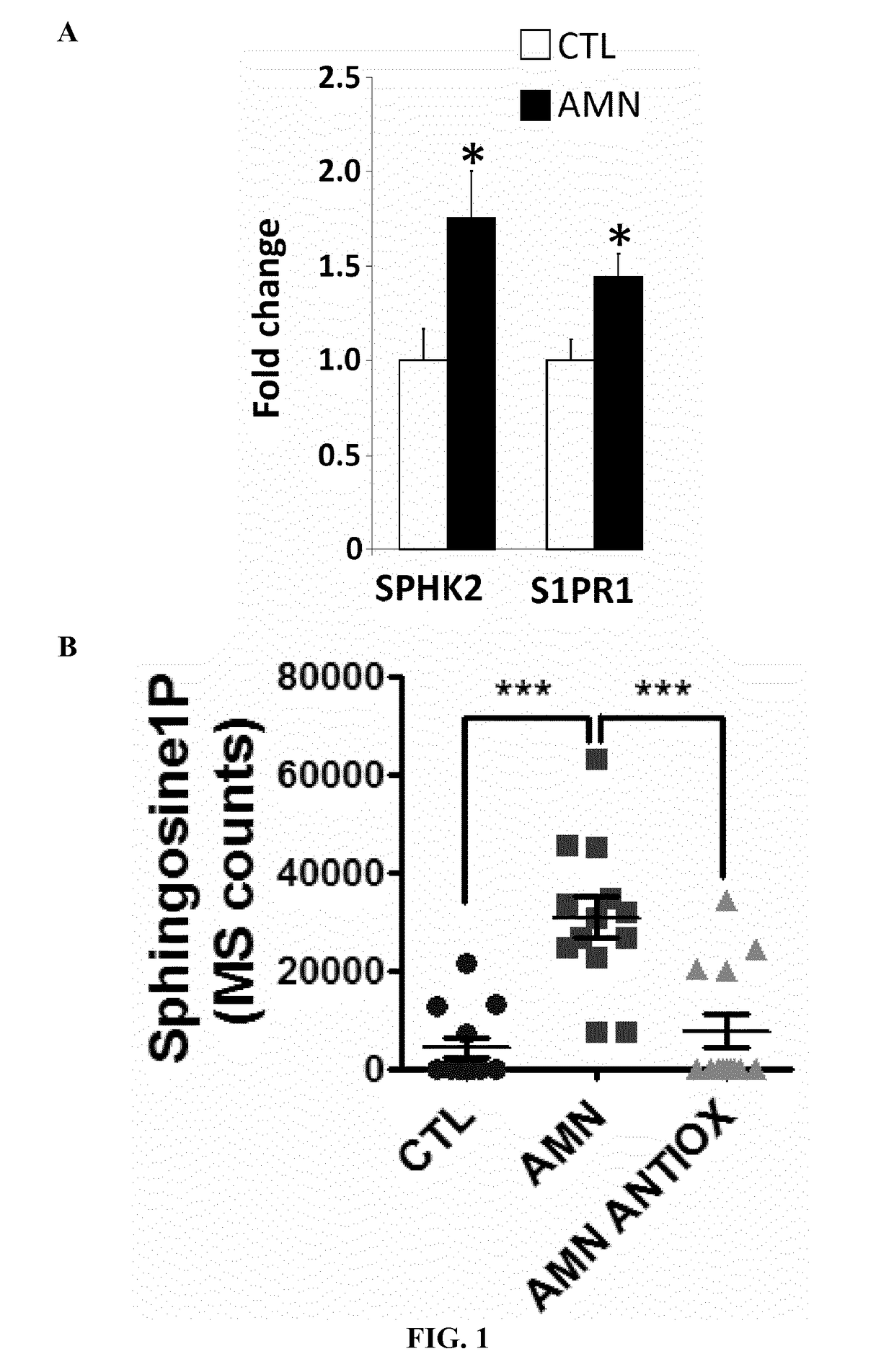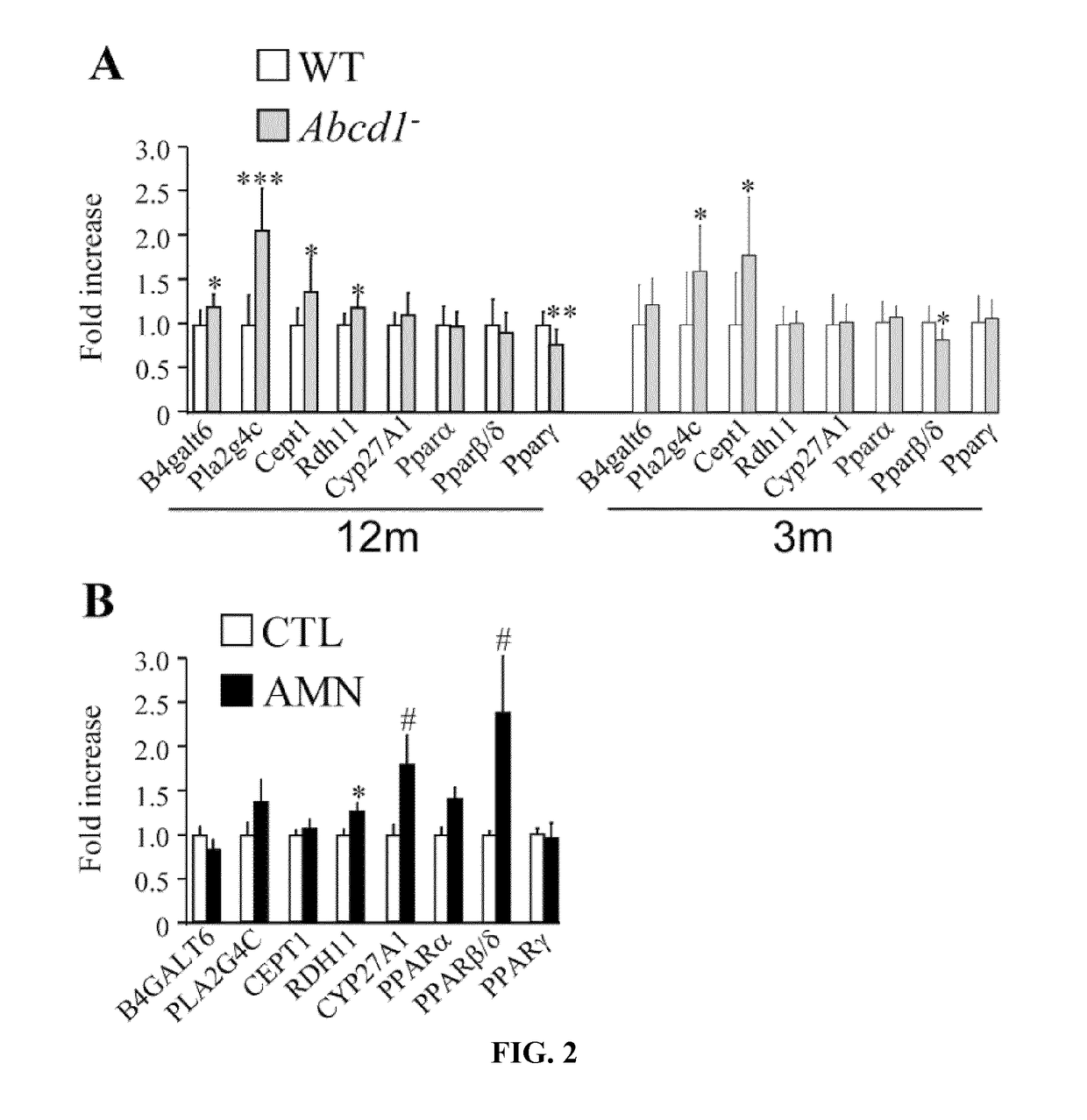Methods and compositions for the diagnosis and for the treatment of adrenoleukodystrophy
a technology of adrenoleukodystrophy and composition, applied in the field of diagnostics and therapeutics, can solve the problems of unsatisfactory treatment to date, and achieve the effects of increasing the sphk product, increasing the level of the sphk2 enzyme and in the sphingosine-1-phosphate receptor 1
- Summary
- Abstract
- Description
- Claims
- Application Information
AI Technical Summary
Benefits of technology
Problems solved by technology
Method used
Image
Examples
example 1
ne-2-Phosphase Kinase and Sphingosine-1-Phosphate Receptor 1 Levels are Increased in Peripheral Mononuclear Cells from AMN Patients
[0288]In FIG. 1A, the inventors performed Q-PCR experiments in PBMC of AMN patients, to identify an increase of SPHK2 (sphingosine kinase 2) and S1PR1 (sphingosine 1-P receptor), two enzymes controlling the synthesis of sphingosine-1-P, to find them increased in AMN patients. In FIG. 1B, the inventors measured the levels of sphingosine 1-P in the plasma of AMN patients using a HPLC / ESI-Q-TOF approach. In AMN patients, the levels of sphingosine 1-P (S1P) were abnormally increased, underscoring the upregulation of the proinflammatory S1P pathway. This result constitutes a strong rationale for the use of inhibitors of the S1P pathway to treat AMN, and also, X-ALD, such as fingolimod, fingolimod analogues, metabolites, derivatives and molecules alike.
[0289]Moreover, the experiment in FIG. 1B shows that a 3-month treatment with a combination of antioxidants (...
example 2
lycolipid and Glycerophospholipid Signalling Drive Inflammatory Cascades in Adrenomyeloneuropathy
[0290]The inventors set out to identify a molecular signature for AMN by conducting a metabolomic / lipidomic analysis on PBMC and plasma obtained from patients and controls. The results were combined with transcriptomic data from spinal cords from the Abcd1− mouse model at different stages of disease progression, using an integrated bioinformatic analysis. Several dysregulated key pathways that were subsequently experimentally validated by independent, complementary techniques were pinpointed.
Metabolomic and Lipidomic Analysis in Plasma and PBMC from AMN Patients
[0291]Plasma and PBMC from AMN patients and healthy, gender and age-matched controls were collected. Lipidomic and metabolomic analysis using mass spectrometry was used to characterise their molecular profile. As there is no single universal method for metabolite extraction, two independent protocols were used to evaluate a wide r...
example 4
es in the Levels of the Biomarkers Between the Severe and Moderate Phenotypes in AMN Patients
[0306]
TABLE 12Differentially expressed biomarkers between the severe and moderatephenotypes in 13 AMN patients included in a phase II clinical trial withantioxidants.ModerateSevereClinical outcomesEDSS1-4.54.5-66MWT (1st visit)350-550150-250improvement1-10%20-60%CytokinesAdiponectin↓↑I136A↑↓CXCL9↓↓↑↑Adiponectin and CXCL9 levels are lower in patients with moderate phenotype as assessed with the EDSS and 6MWT parameters, and higher in more severely affected patients. IL36A shows a different profile, being more elevated in moderate patients. EDSS is a clinical scale of spasticity; 6MWT is a clinical test measuring the distance walked in 6 minutes. Data analyzed with one-tailed paired t-test or one-tailed Wilcoxon signed rank test. Trial registered at ClinicalTrial.gov (NCT01495260).
TABLE 13Best biomarker combinations as predictors of severity using penalizedregression methods. Pearson's correla...
PUM
| Property | Measurement | Unit |
|---|---|---|
| Composition | aaaaa | aaaaa |
| Antioxidant | aaaaa | aaaaa |
Abstract
Description
Claims
Application Information
 Login to View More
Login to View More - R&D
- Intellectual Property
- Life Sciences
- Materials
- Tech Scout
- Unparalleled Data Quality
- Higher Quality Content
- 60% Fewer Hallucinations
Browse by: Latest US Patents, China's latest patents, Technical Efficacy Thesaurus, Application Domain, Technology Topic, Popular Technical Reports.
© 2025 PatSnap. All rights reserved.Legal|Privacy policy|Modern Slavery Act Transparency Statement|Sitemap|About US| Contact US: help@patsnap.com



